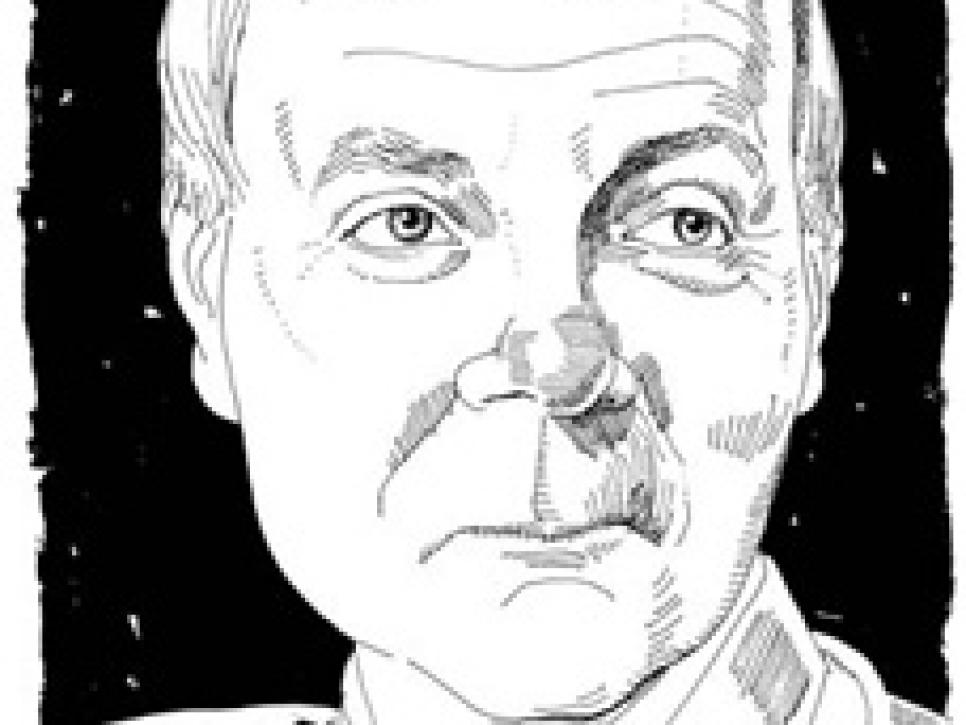18 questions for David Fay

David B. Fay: Executive director of the USGA
Be honest: Isn't there a bit of a letdown when Steve Jones wins the U.S. Open?
Hold on! Steve played gritty golf, fending off Lehman and Love, and he made it to Oakland Hills as a qualifier. It was a compelling story. Now, as a fan, my five favorite Opens since joining the USGA were in 1980, 1982, 1999, 2002 and 2008. Draw your own conclusions as to why.
Define the perfect U.S. Open green.
It's a surface that the players should treat with respect and a dash of fear. It should be noticeably firm and on the speedy side. If the player is too reckless or too cautious playing to and putting on the green, a price should be paid.
Mike Davis is credited with the idea of "graduated rough" in the U.S. Open so the severity of the penalty on wayward tee shots is affected by how far off line they end up. Obvious or genius?
The first person to mention the graduated-rough concept to me was Peter Jacobsen at the 1988 Open. I passed his idea along to our then-decision-makers, but nothing came of it. Shortly after I promoted Mike, he came to me with his course-setup philosophy, which included a greater variety of rough heights. I jokingly asked him if he'd been speaking to Peter! Mike had an advocate in me and the support of the championship committee. He put his ideas into effect for the first Open he was responsible for, Winged Foot in 2006. It was a bold move to make in his rookie outing, and yes, it's been well received.
Who's to blame for slow play, and why don't you ever penalize anybody when a threesome takes five hours to play 18 holes in the Open?
No one and everyone, I guess. Just about all big-league sports, including baseball, football and hoops, are taking longer, and so is golf. And it's not the action itself -- throwing, hitting, shooting -- it's the routines and histrionics leading up that eat up time. Over the years, we've all increased the acceptable time to play a round. Which is a bit like dealing with a weight problem by buying larger-waist trousers. It's easy for slowpokes to beat the system. A player has to be obstinate and/or dumb to get a penalty for slow play.
The U.S. Open is your most important asset. Is everything else a money-loser?
Yes, just about -- our member's program also makes money. We generate income from broadcast fees and a limited corporate-partners program, but without the Open, these wouldn't exist.
The USGA is known as the governing body. What do you govern?
Strictly speaking, we set and enforce our Rules in the national championships that we own and operate. Beyond that, we govern by all the authority not vested in us. Even before you hit your first shot on the opening hole, you're affected by USGA standards in what you're about to do for the next few hours: the Rules you play by (or choose to ignore), the legality of the equipment you play, the handicap off which you may play, and even the condition of the grass on the course. Our work affects all golfers, professional and amateur alike.
You are famously cheap. And the USGA is known for its austerity. Coincidence?
Cheap? @#$%^&*! I'll match my tipping generosity with anyone other than Phil Mickelson. As for my employer, regulatory bodies tend to be austere.
A lot is made of the fact that you answer your own phone. Are you nuts?
I don't like my information filtered.
We hear you have grass you don't have to water. Can I get some of that for my lawn?
The USGA Green Section has helped develop a number of turfgrasses that require less water and chemicals. These grasses are available for sale. Contact one of our Green Section offices for more information.
Why do so few people have a handicap? Can't the USGA fix that?
Most golfers have some form of handicap, but only about 5 million or so have a USGA handicap. The alternative to a USGA handicap is a home-brew number. It's the "I-usually-shoot-around-90-so-I'm-about-an-18-handicapper-but-we-can-adjust-at-the-turn-if-need-be" type system. Home Brew was a system I used until I was 24 and joined a golf club. It works OK if you're playing most of your golf with the same folks. But the "about 18" comment causes lots of raised eyebrows when you're playing with strangers.
The USGA gives away a lot of money -- much of it to grow the game -- but participation continues to decline. What are you investing in that is working?
We've spent more than $60 million in programs designed to give more folks, particularly kids, a chance to give golf a shot and see how it goes. The programs have been fine in introducing the game, but the number of new players hooked on golf through these programs is not so clear. One hope, as it relates to kids, is that even if they can't fit golf into their lives today, they'll be able to do so sometime in the future. There are real limitations to golf's growth that can't be dismissed or explained away. Caddieing was the best way to introduce and hook someone like me who didn't have a link to the game through family and friends. If you live in a part of the country where kids continue to caddie, be thankful, and support caddie programs whenever you can.
Does this economy threaten the USGA's ability to function?
Threaten? No. Alter? Yes. Thanks to our volunteer base, we're able to perform our 100-year-old core programs -- running national championships and writing the Rules and standards -- in bad times as well as good, and we will continue to do so, whether there are 30,000 golfers or 30 million.
What really goes on at the USGA test center? I hear the practice balls are stacked in pyramids for the staff to hit at lunchtime.
These folks test golf equipment for conformity and undertake assorted research projects to ensure that any current or possible technological advances in equipment don't overshadow skill. Balls on the range are in formless piles. No pyramids.
So what's in your bag?
Thirteen clubs made by seven manufacturers. I'll not provide details. No manufacturer would want to be linked to my sorry game.
I hear there's a golf museum in the hinterlands of New Jersey. Is it worth the trip?
A fantabulous, rewarding and memorable experience. And this beautiful location in the New Jersey hinterlands at the intersection of two major Interstate highways is only 50 miles from the country's largest city. For further information on the museum and just about everything else we're working on, please go to usga.org.
Play the game: There's a fire in the museum, and you have time to grab only one thing. What do you save?
The club assembled and used by astronaut Alan Shepard when he walked on the moon. This club is the only tangible evidence of any sport played anywhere other than Earth.
One reader writes: Why is the cash value of a prize I win in an amateur tournament limited to $750? I've lost my job and could use the money.
Because we increased it from $500 a few years back. If you've lost your job and need the money, keep the dough and worry about your amateur status later.
How many blue blazers do you own?
One. Remember, I'm famously cheap.
